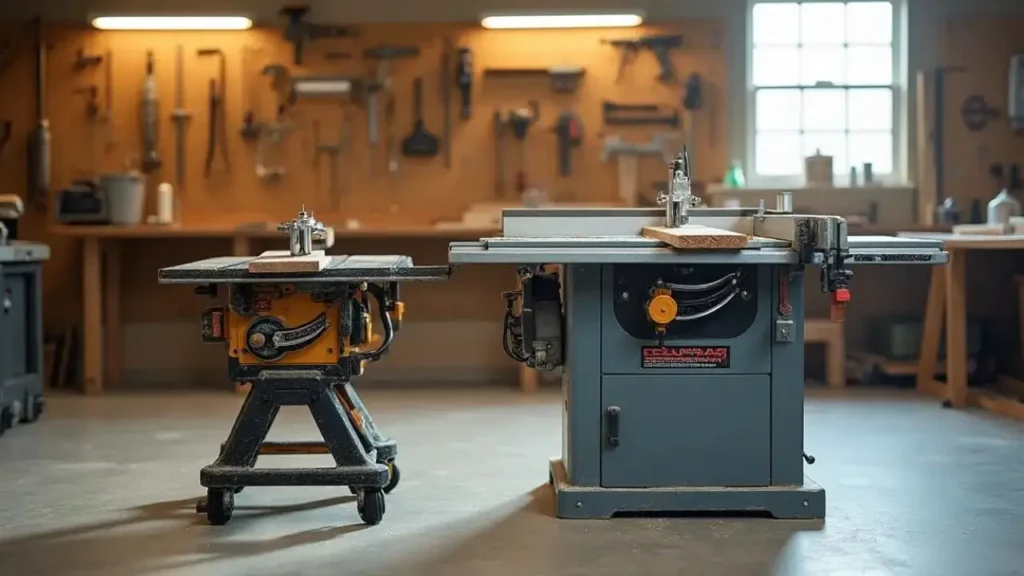Choosing a table saw is a big step. You want the best one, but it can be not very clear. Many guides list features but don’t always explain what they mean for you. This guide is different. We will look deeper This guide is different. We will look deeper to help you choose wisely, especially when considering portable vs stationary table saws.
My goal is to share real user experience. So you can pick your saw like you already know it.
Disclaimer
Affiliate Disclosure
This blog post contains affiliate links. This means that if you make a purchase through these links, Smart AI Gears may earn a small commission at no extra cost to you. We only recommend products and services that we genuinely believe in and have thoroughly researched or used. Your support helps us keep this blog running and continue providing valuable content.
We are a participant in the Amazon Services LLC Associates Program, an affiliate advertising program designed to provide a means for us to earn fees by linking to Amazon.com and affiliated sites.
Please Note: Always follow proper safety procedures when using any type of table saw, whether portable or stationary. Wear appropriate protective gear like safety glasses and hearing protection. Read the manufacturer’s safety instructions carefully. This guide is for informational purposes only and does not replace professional training or advice.
Learn more by reading our Full Disclosure.
Price Disclaimer
All prices mentioned in this review are accurate at the time of publication. However, please note that prices for tools and products can change frequently due to market conditions, sales, and retailer policies. For the most current and exact pricing, always check the product’s official listing on the retailer’s website before making a purchase. We do not guarantee that the prices listed here will remain the same.
Image Disclosure
The images used in this blog post are either our own original photographs, created specifically for Smart AI Gears, or sourced from licensed stock image providers. We ensure that we have the necessary rights to use all visual content. Unauthorized use or reproduction of these images is not permitted.
Portable and Stationary Table Saws: What is Different?
Table saws are mainly two types: portable (you can move them) and stationary (they stay in one place). These differences change how you work. For those comparing portable vs stationary table saws, understanding these core distinctions is key.
Weight and Moving: More Than Just Kilograms
Portable saws are light, 23 kilograms (50 pounds), using aluminum and steel. Stationary saws (like cabinet saws) are very heavy, 130 to over 270 kilograms (300 to 600+ pounds), and made of cast iron.
- What this means: A light portable saw is easy to move if you need space or want to cut outside. A heavy stationary saw stays put. This also means lighter saws can vibrate a little more, which can affect very fine cuts. Heavy saws are very stable and absorb vibrations, helping make smoother cuts.
Power: Not Just Numbers, But How It Cuts
Portable saws (up to 2 HP, 120V) are good for many jobs. Stationary saws (3-5 HP, 240V) are much stronger.
- What this means: A portable saw can cut thick wood, but you might need to go slow, and the motor might strain. A strong stationary saw cuts thick hardwood smoothly and quickly. This “cutting feel” is better for big jobs and makes work more enjoyable. If you often cut thick hardwoods or use wide ‘dado’ blades for joints, more power is a need, not a luxury.
Setup and Keeping: How It Changes Your Work Day
Portable saws often have folding stands for easy storage. Stationary saws need a permanent spot.
- What this means: If you need your saw for quick jobs and then need the space, a portable saw is good. But setting it up accurately every time can be tiring. A stationary saw is always ready and aligned. This saves time and becomes the center of your workshop.
When to Pick Which Table Saw?
Different saws fit different needs. When making your choice between portable vs stationary table saws, consider these scenarios.
Home Fixes and DIY Fun
- Problem: Occasional repairs, small projects, limited space and budget.
- Solution: A benchtop or compact portable saw. It’s affordable, stores easily, and handles basic cuts.
- Think This Too: If your DIY dreams are big (like making kitchen cabinets), you might want a better portable saw with a good fence or a small contractor saw if you have space.
Builders and Job Site Work
- Problem: Need a tough, easy-to-move saw for construction sites. Quick setup is key.
- Solution: Jobsite table saws. They have strong frames, often with wheels.
- Think This Too: High-end jobsite saws can offer good portability and better precision for some finer tasks, but they are not full cabinet saws.
Making Cabinets and Fine Wood Things
- Problem: We need very accurate cuts every time for furniture or cabinets. Work with expensive wood.
- Solution: Cabinet saws (or good Hybrid saws). Their heavy build and strong motors give precise, smooth cuts.
- Think This Too: A good saw helps, but skill is also needed. Good dust collection is very important with these powerful saws.
Schools and Big Workshops
- Problem: We need very safe, strong, and accurate saws for many users and heavy use.
- Solution: Heavy-duty cabinet saws. Brands like SawStop are popular for their extra safety features.
- Think This Too: The higher cost is an investment in safety and durability for these places.
Important Things to Check Before You Buy
Look at these details:
Rip Capacity: How Wide Can You Cut?
This is the space between the blade and the fence. More capacity (e.g., over 24 inches for sheet goods) usually means a bigger, more expensive saw.
Fence System: The Guide for Your Wood
A good fence is key for straight cuts.
- Good vs. Great: A good portable saw fence (like “rack-and-pinion”) locks okay. A great stationary saw fence (like “Biesemeyer-style”) is heavy steel, locks solid with no flex, and is super accurate.
- Tip: When checking a fence, lock it and gently try to wiggle the far end. Does it move or flex? Even a tiny movement means a bad cut.
Blade Size: Big or Small, What It Means
Most portables use 8-1/4 inch blades (good for thinner wood). Pro saws use 10-inch blades (better for 2x lumber, deeper bevels). Bigger blades need stronger motors. Also, check if the saw can take “dado blades” for cutting wide grooves if you need that.
Dust and Safety: Keep Clean, Keep Safe
Saws make dust. Look for a dust port to connect a vacuum. Cabinet saws often have better dust control. For safety, look for a good blade guard and a “riving knife” (helps stop dangerous “kickback”). Special safety systems like SawStop’s are excellent.
My Best Picks for Different People (Examples)
(Remember, prices/models change. These are ideas.)
- Good First Saw: Skil TS6307-00. It’s a good fence for its price, and it helps beginners learn well. Ryobi portables are also okay for very light tasks.
- For Builders: DeWalt DWE7491RS. Great rolling stand, tough and reliable. SawStop Jobsite Saw Pro for top safety.
- For Pro Woodworkers: SawStop Professional Cabinet Saw. Top safety and quality. Hybrid saws (e.g., from Ridgid) can be a good balance too.
Long-Term Costs: What You Pay After Buying
Think beyond the first price:
- Motor Type: Portable saw “universal motors” have “carbon brushes” that wear out and need changing ($10-$30). Stationary saw “induction motors” usually don’t.
- Blades: You’ll likely buy better blades ($40-$100+). Sharpening costs $20-$30.
- Electricity for Big Saws: A 240V stationary saw might need an electrician to install an outlet ($200-$700+).
- Good Extension Cord (Portables): A heavy-duty one ($30-$50) is a must for safety and motor life.
Noise: Is Your Saw a Loud Neighbor?
- Portable Saws: Often VERY loud (100+ decibels dB – like a motorcycle). You must use ear protection.
- Stationary Saws (with induction motors): Usually much quieter (75-90 dB – like a vacuum). Still, use protection, but less harsh. Loud noise makes you tired and is bad for family/neighbors.
Comparison
| Feature | Portable Table Saws | Stationary Table Saws (Cabinet/Hybrid) |
|---|---|---|
| Weight | Around 50 lbs (23 kg) | 300-600+ lbs (130-270+ kg) |
| Power Output | Up to 2 HP | 3-5 HP+ |
| Power Needs | 120V (normal plug) | 240V (special plug, needs electrician) |
| Main Material | Aluminum/steel | Cast iron/heavy steel |
| Rip Capacity | Usually 20-24 inches | Up to 50+ inches |
| Best For | DIY, small jobs, moving | Fine woodworking, and pro shops |
| Cutting Precision | Good (±1/16″) | Very High (±1/64″) |
| Thick Hardwood Cut | Can struggle | Excellent |
| Portability | High | Low (stays put) |
| Dust Collection | Basic port | Better (often enclosed base) |
| Setup Time (Good) | 5-15 mins | < 1 min (always ready) |
| Vibration | Medium-High | Low-Very Low |
| Noise Level | High (100+ dB) | Medium (75-90 dB) |
- 24.5 in. of rip capacity for ripping 4×8 plywood or OSB sheets
- Compact size for easy transportation and storage
- Rack & pinion telescoping fence rails make fence adjustments fast, smooth, and accurate
- Includes full manufacturer warranty
- Includes full manufacturer warranty
- Includes full manufacturer warranty
Conclusion
Portable saws are great for moving and small shops. Stationary saws are best for precise, heavy work.
Before you buy, quickly ask yourself:
- My Next Projects: Will this saw type handle them well?
- My REAL Workshop Space: Permanent spot, or must it be stored? How about dust?
- My Budget Truth: Including extra costs like wiring, blades, and dust collection?
- My Patience: Okay with more setup (portable), or do you need it always ready (stationary)?
- Safety Needs: What safety features are most important for me?
Choosing a table saw is a big step. By thinking about these deeper points, you are now much better ready to pick a saw that will help you do good work for many years. Trust yourself to make a good choice.





